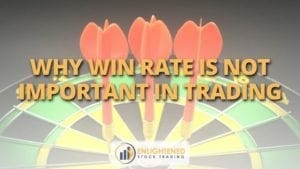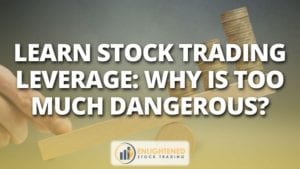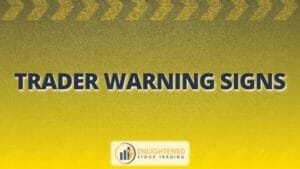The first thing is being consistently profitable, and the second thing is having the discipline to stick to your system. I want to be clear that trading is not like a day job, compared to going to work, getting paid, there is very little consistency in your returns from the market. It’s not like you’re going to earn $100 every day or $10,000 every week or anything like that, it does vary quite a lot. The first thing to realize when you’re going to become a trader is that you have to accept some uncertainty in your income.
You need certainty, and as a human being we need certainty. A lot of traders will say, “Well, how do I make $100 a day? If I can just make $100 every single day, that’d be perfect. I’d be on my way.” But thinking about trying to force a certain profit, a certain consistency out of the market is going to cause you to make mistakes and it’s going to cause you to do things that sub-optimize your performance because if you try and take $100 out of the market every single day, you might miss the big update where you could’ve made $1000. That’s because you took your profit too early, and you got your $100.
The first step is in order to be consistently profitable, think about longer term and think about “How can I make money every year or most years to start with”. And then once you’re making money most years, “How can I make money in most quarters?” And then “How can I make money most months?” If you start out thinking, “How can I make money every day?” it’s going to be a very hard journey for you. And chances are, you will lose all of your money trying to do that because the sort of trading methods that do give you very regular returns on a daily or a weekly basis, tend to have a huge tail risk and cause you to blow up when the risk actually comes to bear. That’s just a bit of context for consistent profitability in trading, think longer term than you would in your day job. Think over months and quarters and years, rather than days and weeks for your definition of consistent.
Second thing is in order to be consistent within those timeframes, you need to be able to make money from the different types of market behaviors that happen. Markets can do several things, it can go up, go sideways and go down. And if markets are going up, they can do three things next, they can go up, go sideways or go down. And if market’s going sideways, they can do three things next, they can turn and go up, keep going sideways, or go down and so on, you get the picture. What you want to do to be consistently profitable is have a system or a set of rules that will make money from various different market behaviors. Most traders start out making money from just the long side. If I buy stocks, they’ll go up, I make money. That’s good and I did that for the first seven years of my trading. (I made a ton of money doing it) But you won’t make money every year doing that because there’s going to be down years and there’s going to be sideways years.
You’d want to expand your horizons as you grow as a trader, to be able to make money from more and more market conditions. If you start out, you want to start somewhere easy and natural for you. And for most people buying stocks on the long side is the easiest and most natural. Shorting is kind of weird but if you buy stocks and they’re going up, you’re going to make money in a bull market. If you buy strong stocks, even if the market’s going sideways, strong stocks can go up so a trend following system is often the best place to start because it’s a very forgiving way to trade. The average winners are huge compared to the losses and you don’t have to do much so if you make little mistakes, it doesn’t matter because you’re not trading 50 times a day. If you start out day trading, you’re trading many times a day. If you make any little number of mistakes, they compound on themselves and you very quickly lose money. You want to start somewhere that’s fairly forgiving, like trend-following and then branch out into systems or approaches that make money in different market conditions so that you’ve got a trend following system. Then you have a meaner version system which buys on a dip to profit from the rally and your trend following system might hold through all those dips and rallies. A meaner version system might just profit from the springback or the reversion to the main and then you might say, “Okay, well now I want to make sure that if the market really turns down and goes down for a long period of time, I’m going to make money.” You need a short selling system, a system that will enter when the markets are weak and likely to continue. The dynamics of a short selling system are completely different than the dynamics of a long side system so you need to first learn the long side and have a system that makes money consistently and then learn the short side. With my students in the Trader Success System, they get access to a whole bunch of different systems, some short and long, or short term and long term. And the idea is you take a few of those systems that you like and you assemble them into a portfolio that makes money in different market conditions. That’s how you become a consistent stock trader by starting profitable with one system and then diversifying into systems that make money from different market conditions.
The second part of this question was how can I be disciplined and stick to my stock trading system. , how do I develop the discipline to stick to that? The discipline comes from your level of confidence because if you know that a system is profitable, or outperforms your crazy tendencies, and if you know that you’ve tested it, that system generates and you have a reaction to it and you go, “Oh, I don’t want to take that trade. I should filter that out.” After you’ve tested that idea with the filter that you’ve come up with and you’ve found that it makes it worse, then you can build the confidence and the discipline to follow the system. The first thing that you need to do to build that discipline is to have a consistent set of rules where you’re completely clear on what you have to do when you buy, or how much you buy and when you sell. You need to be crystal clear on exactly what the rules are. If there’s any ambiguity, you will not be able to master the confidence and the discipline to be able to follow those rules consistently so you need to eliminate ambiguity, which means writing down your rules, codifying them so that you know precisely when the buy and sell is.
Second step is to backtest those rules. It’s no good saying, “Hey, I looked at a few charts and I looked at this indicator and look I would have bought here and I would have sold there. And I would have made this much money. And then… Oh, look, there’s another trade here. I would have bought there. And I would’ve sold there. And that would have made money.” That’s not backtesting and that is not going to give you the confidence to have the discipline to follow your system rules.
Real backtesting is when you take your specific codified rules and you put them into a piece of software like AmiBroker, that’s what I use and what most of my students in the Trader Success System use for backtesting. Put them into AmiBroker, you back test them over 20 to 30 years of history, generate several 1000 trades using those rules, and verify that the system is profitable and stable that makes money over time. You have to consider that age is not decaying, and that those rules are robust and it means if you’ve got a moving average of 200 day in your system and is profitable. But if you change it to 180 day moving average, and the system is not profitable anymore, that’s not a good system so you need to have confidence that your system is robust. Robust means if you vary the indicator parameter values a little bit, it won’t matter because it’ll still make money. When you back test your system, and it back tests profitability with 200 day moving average, and it also back test profitably with 150 or 250 day moving average, you’ve got a high degree of confidence that that rule works.
It doesn’t matter because you’re going to have to fine tune it to make it profitable. It’s all about having a robust system, when you back test your systems like this, you build that confidence. When you trade them, you’re looking at each signal the system is generating and then you observe your emotions as you’re trading and you’ll get a signal and go, “Oh, that stock, look how gappy it is. I don’t want to trade that.” It’s like, “Ah, that’s not going to be profitable.” This is the emotional reaction we have when we trade systems so what you do is step one, observe you had a reaction. Step two, look at the chart and say, “Why did you have a reaction? What was it that you reacted to?” And in this case, it was the gappy stock chart that was all over the place. The third step is to take that observation and convert it to a rule. You don’t want to trade a stock if it has lots of gaps so you write a filter to eliminate those sorts of stocks, put that into your system and back test it with that rule. Backtest it with or without the rule to see which one is better. The interesting thing for your trading psychology is that the vast majority of the time when we have an emotional reaction to our signals, it is not a profitable reaction.
If I tested 98 emotional responses that my systems told me to take, and I created a filter to try and remove that sort of trade, 98 out of 100 would not help. They would actually make my system worse but every now and then you’ll see a trade, you’ll have a reaction and you’ll come up with a rule to try and eliminate that sort of trade and that will improve the system. If you find a rule that improves the system, you’re going to be able to make more money.
Building this confidence and discipline to stick to the system is first around backtesting, second about observing our emotional reactions and validating that those emotional reactions are unfounded by putting those rules into the system and seeing that the system actually decays. Every now and then we have an emotional reaction to a trade we’re supposed to take so we put in a rule and we go, “Oh my God, the system got better.” It’s like a little pot of gold you just found. You can put that rule into your system and it will be more profitable from then on. That’s how you generate to become a consistently profitable trader by having the right systems and then the discipline to stick to them by back-testing and also back-testing your emotions. Most traders just try and suppress the emotions, but you’re human, you cannot suppress the emotions. You’ve got to observe them, articulate what it was, convert it to a rule, back test it and see if that emotion was founded in profit or not. If it made the system better or worse, most of them you’ll see make the system worse.
When I started trading systematically for the first three years, every day or two, I would see a trade and have a reaction and go, “I don’t want to take that signal.” And so I would constantly be doing this testing of these ideas and gradually I would have less and less emotional reactions to the trades my system generated because I knew through experience of testing that my reactions were not profitable. If I acted on them, they would destroy profit. That’s why back testing is the key to all of that, building that profitability, building that confidence in cementing your trading psychology.
For more stock market questions, click here to find all my questions on YouTube









Greetings! This is my first visit to your blog! We are
a collection of volunteers and starting a new project in a community in the same niche.
Your blog provided us valuable information to work on. You have done a extraordinary
job!
I am glad you are finding the site helpful for your trading – Thanks for stopping by!!
Adrian